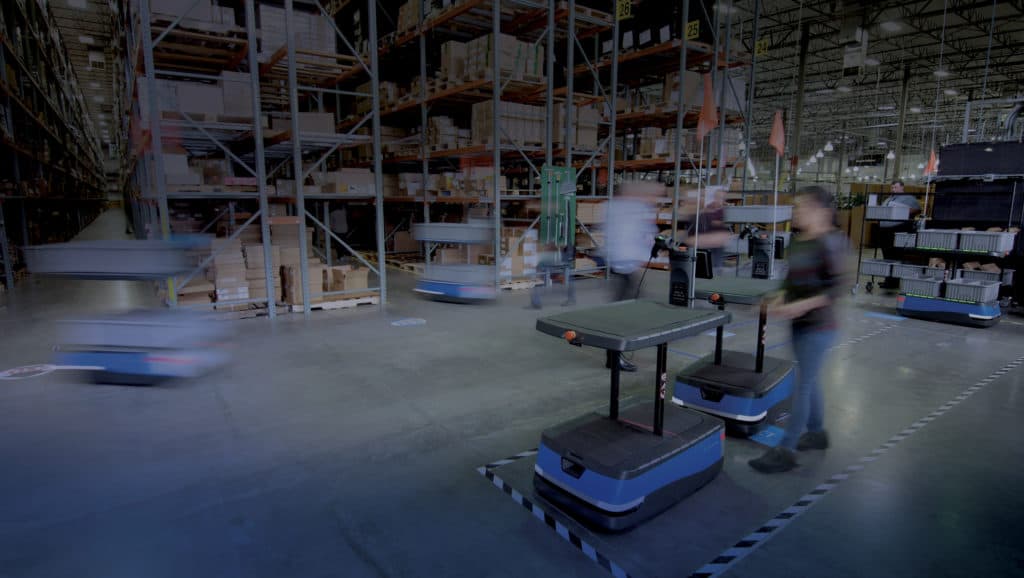Most warehouse operations are on an ongoing mission to maximize the productivity process by optimizing workflows, automating processes and reducing waste (both time and resources). Warehouses are complex operations with many moving parts and functions happening simultaneously, so while there are plenty of areas to improve warehouse productivity, it’s not always easy to determine where your efforts will pay off.
Advances in logistics technology, such as automated robots, have a big impact on warehouse productivity, along with innovative AI and machine learning solutions, sophisticated warehouse management software and other technology solutions. Taking a look at your current processes and systems to identify bottlenecks and other concerns, implementing process improvements and making smart technology investments that address your key challenges puts organizing a warehouse and improving warehouse productivity within reach.
To help you evaluate your current systems and find opportunities for improvement, we’ve rounded up 50 expert tips on improving warehouse efficiency and productivity, from management and leadership advice to tips for improving your warehouse organizations, layout, and workflows. Click on a link below to browse warehouse efficiency tips and improvement ideas in a specific section:
Management & leadership tips

1. Introduce incentive pay. “Properly engineered incentive pay for performance can bring the biggest percent improvement in labor productivity. More than 50% of your warehouse labor is in pick and pack, so start there. You always need to be sure you’re not paying for productivity you’re already getting or could get in other ways.” — Curt Barry, 10 Ways to Improve Warehouse Efficiency and Reduce Costs, Multichannel Merchant; Twitter: @mcmerchant
2. Invest in quality training processes. “Hiring quality people is just the start. To keep them on track and help them grow, you need to emphasize training. Training sessions should regularly be conducted in short increments of 45 to 60 minutes. They should be hosted by direct supervisors whenever possible and take on more of a conversational tone than one of lecturing.” — Larry Alton, Apply These 6 Tips to Improving Productivity and Efficiency in Your Warehouse, Small Business Trends; Twitter: @smallbiztrends

3. Prioritize safety. “Safety should be a priority in your warehouse since without smart safety practices you face dangers and accidents that lead to inefficiency and profit loss. Skimping on safety might save you money in the beginning, but accidents are incredibly costly.” — The 5 Best Ways to Increase Warehouse Efficiency, Freight Cowboy; Twitter: @freight_cowboy
4. Cultivate effective front-line leadership. “The best managers are leaders that meticulously monitor, plan and manage all aspects of fulfillment. They are continuously developing their skills so that they can swiftly recognize and address new problems. Warehouses with managers that have access to training resources and exposure to other angles of the business will be most effective in improving warehouse efficiency.” — How to Maximize Warehouse Efficiency, Parcel Pending; Twitter: @ParcelPending

5. Establish a culture that promotes productivity. “The culture you establish will determine every aspect of how your company performs, and you should seek a warehouse culture that is interesting, creative and fun. In addition to asking your employees for new ideas, create additional ways for them to be engaged in their work. Monthly competitions, company events and other concepts that create a more interesting and fun environment will only have a positive impact on your warehouse.” — Thomas Oppong, 5 Ways to Improve Warehouse Efficiency, All Top Startups; Twitter: @Alltopstartups
6. Listen to employees. They have valuable insights on process shortcomings and other productivity-slowing issues. “…you can use the advice from your employees to improve warehouse efficiency. The warehouse staff are the ones who know directly about the strength and the weakness of your warehouse management system. That is why you can spare your time to listen to the advice from your warehouse’s staff because they are the ones who identify and overcome the problem directly from the warehouse.” — 4 Ways to Improve Warehouse Efficiency, Karawang

7. Maintain good relationships with suppliers. “It’s easy to overlook, but a vital component of a well-functioning warehouse is a healthy relationship with suppliers. After all, if you don’t have a product to store and ship, you don’t have a business. Warehouse technology tools, such as GPS systems and barcode scanners, are making it easier than ever to maintain relationships with suppliers.
“As long as the warehouse and its suppliers are technologically compatible, it’s easy for warehouses to update suppliers with information about both short- and long-term needs. It also makes it simple for suppliers to keep the warehouse informed about the status of its product.” — Improving Warehouse Efficiency for Companies in Ecommerce, The Next Scoop; Twitter: @TheNextScoop
8. Cross-train your warehouse workforce. “Cross-training, or training a team of workers to perform different tasks, can be instrumental in boosting productivity in a warehouse. Having highly-specialized warehouse workers can lead to inefficiencies. If a worker needs time off, for example, you might not have any other employees capable of taking over. The current competitive warehouse market and warehouse labor shortage both lead to high turnover rates — exposing your warehouse to efficiency problems if you lose an essential specialized worker. Cross-training your workforce eliminates these issues.” — David Hair, Improve Warehouse Efficiency With a Different Approach, nGroup; Twitter: @nGROUPpartners

9. Focus on employee retention to reduce labor costs. “Labor is an enormous chunk of any warehouse’s operating budget. Paying employees less is not an option, but reducing their dwell time will improve profits overall. Time is money, and idle employees are not contributing to the coffers.
“There are several other suggestions to put into place immediately. Focus on employee retention. It is less expensive to pay an experienced employee than it is to hire and train a new one. Offer cross training and provide continual training seminars on new procedures to improve productivity.” — 8 Tips to Reduce Warehouse Costs, Industry Today; Twitter: @Ind_today
10. Maintain a flexible workforce. “With the changing market conditions and increased customer specifications, having a flexible workforce is important. A balanced personnel ratio target will allow you to meet the fluctuation of production demands at anytime. Team members should be trained through formal programs and receive ongoing training throughout employment. Daily stand up meetings are imperative to the productivity and flow on a shift, and are an easy process to implement.” — Elizabeth Scolari, Lean Warehouse Management: Challenges & Strategies, Handshake; Twitter: @handshake

11. Apply standard measurements to gauge performance. “The warehouse operation is not the same as a production line and warehouse staff does not perform the same repetitive tasks each shift. However, they do perform a number of similar tasks over a period of time. To measure the warehouse productivity, the management must apply standard measurements that can be used for operations that occur in the warehouse, for example, perform physical inventory or place goods in the picking area.
“However, in the warehouse, there is any number of factors that can change the time taken to perform a task. The use of enterprise resource planning (ERP) systems can easily calculate the length of time an operation can take to perform, but a standard measurement must be calculated using a sampling method or time study. Only after the standard measurements are agreed upon can the benefits of any labor measurement can be enjoyed.” — Martin Murray, Measures of Warehouse Productivity, The Balance Small Business; Twitter: @thebalance
12. Recognize your top-performing employees. “Your top performing employees are more than your best producers — they are the lifeline of your operations and role models for new employees. Reward them with verbal recognition and service awards such as gift cards and preferred parking.” — 10 Warehouse Management Tips to Optimize Productivity, RBW Logistics; Twitter: @rbwlogistics
Safety & process improvement

13. Conduct an audit. “You can’t improve something that you haven’t actually analyzed. It is important to gauge if you are using your available resources to the fullest. Is there a flow of goods in and goods out? Any inefficiency within the chain will impact negatively throughout the whole process. Quite often this means that to resolve a problem in the system, the whole system has to be reviewed. It’s no use enforcing a new system in one area if something else isn’t working correctly.” — 8 Tips to Improve Warehouse Efficiency, Vero Solutions; Twitter: @solutions_vero
14. Have experienced workers handle put-away tasks. “Use experienced employees in receiving, they know the products and understand how to stock bins and shelves. Have new employees start by filling orders. It helps them learn the products, customers and paperwork (or electronic inventory) system. It’s also easy to check their work as orders are packed for shipment.” — 7 Tips to Improve Material Handling Efficiency, MCFA

15. Use forecasting to plan resource allocation. “Most businesses experience periods of high and low volume, often varying by season. For example, many manufacturers see an increased demand in Q4 with the approach of the holiday season. Putting systems in place can help businesses to plan ahead on how to manage resources, coordinate staff shifts and utilize space during periods of strain or slowed workload.” — 5 Tips for Improving Your Company’s Warehouse Efficiency, Bear Staffing; Twitter: @bearstaffing
16. Use proper labeling. “An informative label can mean the difference between an efficient and well run warehouse receiving operation and a receiving dock filled with lost products and inefficiencies. No matter what type of inventory control system is used, all receiving labels should include some basic pieces of information.
“That vital information includes the name of the supplier, the associated purchase order number, the pallet label and quantity, the case label and quantity, the product number, the description, the package count and the SKU.” — How to Improve the Warehouse Receiving Process, Floship; Twitter: @floship

17. Identify your KPIs. “A warehouse management solution can help you to track the right things, such as metrics, directly linked to profitability and efficiency. It also can help you to quickly take a look at your most important KPIs and make sure each is tied to a tangible productivity or expense, like inventory accuracy and hours and days to customer. KPIs closely aligned with warehouse pain points — or possible future expenses, like energy efficiency factors — can make it easier to justify expenses and track improvements that really matter.” — Warehouse management: How to improve efficiency, UPS; Twitter: @UPS
18. Maintain your warehouse equipment. “Lift trucks and other equipment your workers use in the warehouse need regular maintenance. A breakdown during use wastes time and costs money in repairs. Create a rotating schedule to pull machines out for routine maintenance. Doing so will ensure you always have trustworthy equipment available for your workers when they need it. With regular maintenance, you also will save the cost of calling for emergency repairs or replacing a piece of equipment.” — 4 Easy Ways to Improve Warehouse Efficiency, Bulk Bag Reclamation

19. Secure the warehouse. “It’s vital to safeguard warehouse facilities by prohibiting unauthorized people inside and near the inventory. This protects both the property and warehouse employees. Post signs in areas where only warehouse personnel are allowed and install physical barriers (safety upgrades) in key areas. Consider badges or uniforms so that authorized warehouse employees can be more easily identified. Inventory is the lifeblood of a warehouse. Make sure to safeguard it!” — 7 Ways to Improve Warehouse Efficiency, Storee; Twitter: @Storeeconstruct
20. Map out your key processes. “Start by mapping out key processes. Brown paper all the activity involved to create a visual. If it’s a picking process, how does the associate receive the order? How do they travel? What equipment are they using? Are they grabbing two or three at a time? Are they taking too many steps? Are they parking the jack in the wrong place?
“This process analysis is a great opportunity to get input from associates on how to improve. Once you identify all the opportunities to take steps and time out of the process, document your optimized process to create a uniform SOP that can be implemented across all operations.” — Bill Jozefowicz, Back to Basics: An Answer to Improving Warehouse Efficiency, Weber Logistics; Twitter: @WeberLogistics

21. Standardize processes. “All repetitive activities should be standardized and documented. Repeatable processes create efficiencies, reduce errors and help with labor planning. Documented processes also help to accelerate the on-boarding of new employees and contribute to their long-term success.” — Warehouse Efficiency and Your Bottom Line, Fidelitone; Twitter: @Fidelitone
22. Reduce the risk of injury with ergonomic interventions. “Injuries in the warehouse and storage industry significantly are higher than those in other industries. For some injuries, the rates are more than double those found in other industries. As a result, investigating the causes of injuries and implementing ergonomic interventions to minimize the risk associated with activities is important.
“Individual workers, managers and engineers can take steps to decrease ergonomic risk factors. Employers and managers should teach and reinforce the use of proper lifting techniques, ensuring the worker’s body is aligned with the part so that no back twisting is necessary and body postures are close to neutral. Items should placed at workstations with consideration given to frequency of use and weight and bulk of items. Mechanical assistance should be provided when necessary, and can include lifts, pickers, fork trucks, hand trucks, carts, conveyors, roller tables, pallet lifts, scissor lift tables or other similar items.” — Brandy Farris Ware and Jeffrey E. Fernandez, Warehouse Ergonomics/Tips And Techniques To Decrease Injury Risk, EHS Today; Twitter: @EHSToday
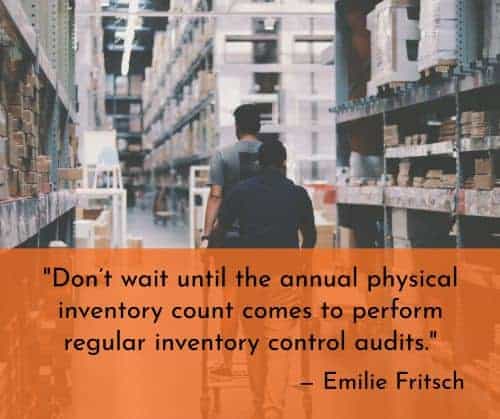
23. Perform cycle counts. “Don’t wait until the annual physical inventory count comes to perform regular inventory control audits. Perform cycle counts and analyze their discrepancies to perfect the time it should take you to go through all locations. For those of you who don’t know, cycle counting is a type of perpetual inventory counting that takes places in waves over time. Only small subsets of inventory are counted during each wave. It’s good to have cycle counts go through all locations every quarter so that you have a more accurate back-office system.” — Emilie Fritsch, Warehouse Inventory Management: 10 Tips You Need to Know, SkuVault; Twitter: @skuvault
24. Conduct an ABC analysis. “On average, 60% of your warehouse workers’ (or picking-robots’) time is spent on transporting themselves around the warehouse. Since so much time is spent on transport, a highly effective way of increasing the efficiency of your warehouse operations is to ensure that you store goods in the right part of the warehouse.
“The stock keeping units (SKUs) that you are picking and transporting most frequently should be placed in the most accessible areas of the warehouse and close to the shipping area, whereas the SKUs that you almost never touch should be placed in the off-beat, dusty and hard-to-reach part of the warehouse. A well-proven tool to ensure this is the ABC analysis.” — Lars Smith Christoffersen, Improve Your Warehouse Operational Efficiency, Implement Consulting; Twitter: @implcg

25. Track and manage damage rates. “This critical step allows your organization to stay in front of the numerous costs and consequences associated with damaged products including markdowns, customer dissatisfaction and returns. By monitoring damage rates, you can measure packaging, suppliers and logistical issues as they arise, allowing your company to take action before the bills accumulate. Oftentimes, simple packaging designs and handling procedures can go along way to improve your damage rates.” — Alex Turner, 3 Key Steps to Improving Packaging Efficiency, Chainalytics; Twitter: @Chainalytics
26. Reduce touches. “Unnecessary motion creates operational inefficiency. One useful approach to improving warehouse efficiency is to examine the packing process and eliminate unnecessary movement or ‘touches.’ Examine the steps in your processes. By streamlining the steps and reducing the number of touches involved, you can help workers make better use of their time and improve productivity.” — How to Improve End-of Line Warehouse Packing Efficiency, Better Packages; Twitter: @WATisbest

27. Keep an eye on fulfillment performance. “When a warehouse team goes from 50 to 75 orders shipped daily, it is a marginal improvement at best if 20 orders are now inaccurate. Fulfillment is about giving the customer what he wants and when he wants it. Direct measures such as on-time orders, order accuracy and shipping damage can be gleaned from customer complaints and feedback. New customers and customer retention compared between time periods such as quarterly or annually can illustrate customer satisfaction with both product and fulfillment.” — Scott Shpak, How to Measure Warehouse Efficiency, Bizfluent
28. Use fewer standard packaging containers. “It is tempting to use hundreds of types of packaging containers in order to export products. However, this is a largely inefficient practice that serves no real benefit. Upper-level management is faced with too many choices, and it becomes tempting to constantly switch their choice of container. When this gets carried down to the workers in the warehouse, it is more time that must be spent accounting for every single feature.
“The efficient way to tackle this problem would be to limit yourself to three standard packaging containers that can be used for the majority of products that the warehouse handles. Orders are put together faster, and freight expenses are consequently lowered.” — Cory Levins, Simple Ways to Improve Warehouse Efficiency, Air Sea Containers; Twitter: @AirSeaContainer
Technology tips

29. Use automatic identification and data collection (AIDC). “Only about 64% of warehouses and distribution centers are using handheld computers with built-in barcode scanners, and only 59% of supply chain decision makers say their companies are using handheld barcode scanners, per research from Zebra Technologies. However, within the next 10 years, those numbers are expected to reach 97%, representing 33% and 38% increases, respectively. Using barcode labels on products, cases and pallets can improve warehouse efficiency and productivity immensely. Barcode labels also play an essential part in improving inventory accuracy — letting warehouse personnel know what’s available, in what quantities and exactly where to find it. Costs for the necessary wireless infrastructure, hardware and software have decreased, making auto ID systems a more worthwhile investment than ever before.” — Eric Sutter, 5 Smart Ways to Improve Warehouse Efficiency and Reduce Costs, EMS Barcode; Twitter: @EMSBarcode
30. Leverage ML and AI to streamline supply, demand and inventory management. “Machine learning is another aspect of AI, which is becoming more prevalent nowadays. It can analyze complex data to establish current patterns and future trends, then make decisions based on outcomes. The use of machine learning can help to manage the flow of goods throughout the supply chain, ensuring that raw materials and products are in the right place at the right time.” — Marc Wins, Using Artificial Intelligence to address Supply Chain Challenges, Supply Chain Academy

31. Adopt technologies to support hands-free operation. “Mobile barcode scanners are just one example of hands-free operation in warehouse. Other innovations such as wearable tech, AR and RFID are also offering the same luxury. RFID and barcode technology can be operated hands-free or without any human intervention in some cases. Additionally, wearable technology and augmented reality (AR) can display the required product information without even having to handle the product.
“This means that hands-free operation in warehouses is becoming more and more possible. With hands-free technology, you can improve tasks such as viewing pick or pack lists, scanning items and locating bins, among others.” — Bobby J. Davidson, How Mobile Technology Can Help Increase Warehouse Efficiency, Percento Technologies; Twitter: @bobbyjdavidson
32. Focus on cognitive supply chain management. “Supply chain logistics networks can now be optimized in real-time, based on proprietary and non-proprietary data, and used to render a decision in a fraction of the time and at a fraction of the cost it would previously have taken.
“This development has led to the beginning of a new era in supply chain management. We are moving out of the age of transactional supply chain management and into the age of cognitive supply chain management. Transactional supply chains are characterized by: a narrow focus on discrete tasks that optimizes processes rather than end-to-end outcomes; static and siloed data that is refreshed at relatively long intervals; local optimization that does not account for global conditions throughout the supply chain network and reactive decision-making that is also relatively slow. In contrast, cognitive supply chains are characterized by: a focus on optimizing end-to-end outcomes within the supply chain network; data that is dynamic, refreshed in real-time and collaborative; global optimization and adaptive decision-making that accounts for the cadence at which business operations occur.” — Brian Aoaeh, Logistics network optimization – why this time is different, Freight Waves; Twitter: @FreightWaves
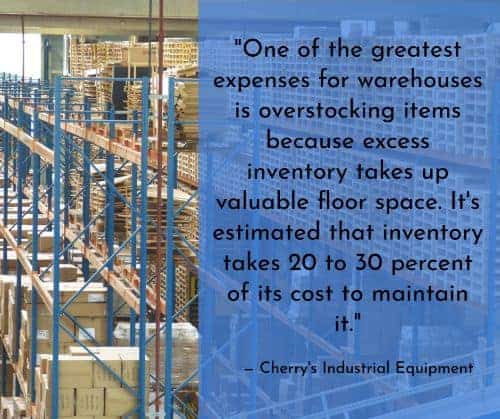
33. Avoid overstocking by tracking inventory. “One of the greatest expenses for warehouses is overstocking items because excess inventory takes up valuable floor space. It’s estimated that inventory takes 20 to 30 percent of its cost to maintain it. Equip staff with quality tracking devices to stay on top of inventory and reduce costs. Get rid of excess and regularly re-slot inventory to reflect customer demands.
“Also, by ensuring accurate tracking of inventory, you make sure you have enough supplies to fulfill orders for the current month and the following month. If there is not a good tracking system in place, items can easily disappear, and customers can become frustrated if products are not in stock. It’s important to find the right balance between overstocking and understocking.” — Tips for Improving Warehouse Efficiency, Cherry’s Industrial Equipment; Twitter: @CherrysInd180
34. Implement a good warehouse management system. “Results from APQC’s Open Standards Benchmarking in logistics show that organizations using WMS have more efficient and accurate warehousing processes and lower overall warehouse logistics costs, although the cost to operate warehousing at these organizations is higher than at organizations without WMS.
“Warehouse Efficiency Organizations that have implemented WMS report higher perfect order performance than organizations without these systems. The results indicate that organizations using WMS are better able to deliver customer orders on time, complete, without damage and with accurate documentation. The difference in performance between the two groups is 4% at the median, which is significant from a customer-facing standpoint.” — Becky Partida, Improve Efficiency within the Warehouse, Industry Week; Twitter: @IndustryWeek

35. Rely on real-time data to avoid overcompensating for inventory inaccuracies. “Inaccurate information about warehouse inventory levels creates problems, such as stock being unavailable for sales or shipping, which in turn leads to backorders. Managers all too readily overcompensate, creating excess inventory that does not move and takes up valuable warehouse space. This can be minimized by deploying warehouse management software that integrates with key systems and provides real time data with alerts to head off such situations.” — Lean Practices in Warehouse Operations, Infoplus; Twitter: @infopluscommerc
36. Leverage collaborative mobile robots to handle massive demand increases. “During peak, it’s common for warehouses to handle massive demand increases… and massive recruiting and training challenges. Daily volumes balloon anywhere from 3-10x average days. So HR departments scramble to hire up to 5x more staff than needed, and warehouse managers spend precious hours training new hires at the expense of the entire team’s productivity. And then the plot-twist: the new hires they spent weeks onboarding walk out the door with all that knowledge, ready to put it to work at another facility that might be paying them just a quarter more per hour.
“Something’s got to give.
“At 6 River Systems, we’ve designed a solution that helps warehouses handle the demands of their peaks. Our solution, made up of collaborative mobile robots we call ‘Chuck’ and cloud-based software, is easy to use, scalable and establishes predictability around your peak labor and throughput.” — Jerome Dubois, How we help you solve warehouse labor challenges during peak, 6 River Systems; Twitter: @6riversystems

37. Make smart technology investments. “Keeping up with technology is an important factor in running at maximum productivity. The easier it is for employees to perform job functions, the more productive they will be. The ease of obtaining data is also a factor in keeping the latest technology within your operation. Watching those KPIs is simple when your equipment can help you track performance. But don’t get caught up in the excitement of the latest technology without doing proper research first. If it makes good business sense and provides a good return on investment, then that investment is a good decision.” — Julie Basello, Five Tips for Improving Warehouse Productivity, Radwell; Twitter: @Radwell_Intl
Workflow & layout tips
38. Organize workflows. “Organizing workstations improves productivity because workers do not have to search for tools or equipment. Use the ‘5S’ method from lean manufacturing to ensure your workstations are as organised as possible. It consists of: Sort; Set in order; Shine; Standardize and Sustain — all techniques designed to keep clutter at bay, reduce errors and improve safety and organization.” — Denny Hammack, Five simple ways to improve warehouse efficiency, CIPS Supply Management; Twitter: @SupplyMgmt

39. Design workstations to suit the task. “The Occupational Safety & Health Administration (OSHA) reports that musculoskeletal disorders (carpal tunnel syndrome, tendinitis, muscle strains, lower back injuries, etc.) are one of the leading causes of workplace injuries and illnesses. To reduce the risk of such injuries in repetitive, manual tasks, it’s important to design workstations according to the specific task and worker (for example, ensuring work surface height is the height of the conveyor or roller from floor level). Doing so increases ergonomic benefits and drives greater efficiency and productivity in everyday work.” — Jennie Dannecker, 10 Ideas for More Efficient & Productive Warehouse Operations, Cerasis; Twitter: @Cerasis
40. Integrate packing and shipping stations. “Traditionally, warehouses have distinct packing and shipping stations. The model is that the order first comes to the packing station, and then it’s sent along the conveyor to the shipping station (where it’s shipped). There is no reason why these two tasks can’t be integrated into one.
“The benefits of doing this include:
- You use less labor.
- You streamline the fulfillment process.
- You free up warehouse space, which allows you to handle more volume.” — Chuck Torrens, Warehouse Optimization: How to Improve Warehouse Efficiency, Creative Logistics
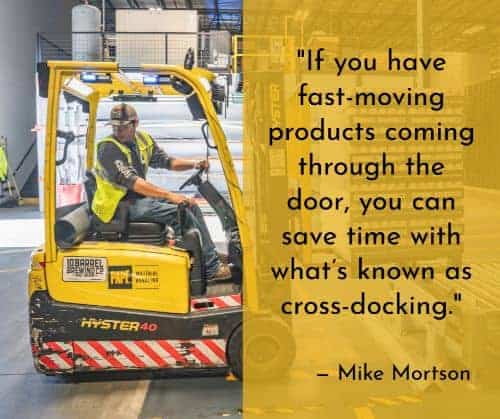
41. Use cross-docking to save time. “If you have fast-moving products coming through the door, you can save time with what’s known as cross-docking. Instead of putting these products back on the shelf only to have your employees retrieve them hours later, direct them to a temporary staging area for scanning and inventory purposes.
“This temporary staging area should be close to the loading dock. When the products are ready for the next leg of their trip, your employees can quickly retrieve them and get them out the door without having to look for them on the shelf.” — Mike Mortson, 6 Tips for Improving Warehouse and Distribution Center Efficiency, Supply Chain Game Changer; Twitter: @mmortson
42. Implement a location numbering system. “Some warehouses do not utilize a standard form of assigning warehouse locations to individual storage positions in the warehouse. This leads to confusion and inefficiency. Make sure you implement a location numbering system that can be used to easily and systematically identify each warehouse location. A numbering schema that utilizes some form of identifying the zone, aisle, bay, level and position for locations is recommended.” — Improving Small and Medium-Sized Warehouse Operations, F. Curtis Barry & Company; Twitter: @FCurtisBarryCo

43. Maintain product slotting. “Product slotting can degrade over time if it is left untouched. SKUs change or are added and deleted, and warehouse workers change the way they operate. Much of the time, workers may put items in the most convenient area to save time during a rush, without considering the long-term consequences of that unorganized action. Studies show that the average warehouse has about 50 percent of its SKUs in the wrong spots. Bad slotting can account for a penalty of up to 20 percent on order picking productivity. Ensuring workers are doing things the right way each time, instead of taking shortcuts, will go a long way to ensuring a more accurate order picking process.” — How to Improve Order Picking Productivity in Warehouse Management, APS Fulfillment; Twitter: @apsfulfillment
44. Use value stream mapping to visualize workflows. “Value stream mapping is a process that enables warehouse managers to understand how things are currently working. Workflow is visually mapped out and relationships among processes are clearly identified, enabling warehouse managers to:
- Understand how various processes interact
- See how scheduling and departmental workflow affect operations
- Identify potential gaps in their processes
“By creating a visual map, warehouse managers can identify materials that are being stored ineffectively or handled too often. They can also improve the warehouse layout and storage system to reduce handling and improve how items are stored. For example, fast-moving items should be easy to reach, while slow-moving items can be placed towards the back of the warehouse or at the top of the storage rack.” — Joel Bradbury, Warehouse Management, Graphic Products; Twitter: @GraphicProducts

45. Reduce travel time. “Travel time in warehouse refers to the amount of time that is spent on walking or moving between the slots or different stations. Time taken for picking tickets, packaging and shipping affects overall productivity. One way to reduce travel time is by optimizing the in-warehouse routes and unnecessary legs in order picking.” — Kevin Hill, 6 Tips for Maximizing Efficiency and Productivity of Warehouse Operations, Supply Chain Minded; Twitter: @scminded
46. Incorporate ample cross aisles. “A vast warehouse with rows of racking marching into the distance might look impressive, but such a set-up is likely to murder your warehouse layout efficiency. Make it easier for operatives to move around your warehouse by creating plenty of cross-aisles. A top-down view of your warehouse should look more like city blocks than a 10 lane superhighway. While the four sources of inefficiency and cost described here might seem like common sense, time has a way of eroding the good work done in initial warehouse layout planning.” — Rob O’Byrne, 4 Ways to Improve Warehouse Layout Efficiency and Save Costs, Logistics Bureau; Twitter: @LogisticsBureau

47. Consider a velocity-based layout. “Many distributors set up a facility the way they buy their inventory: they group all products from the same manufacturer together and put them in catalog order. Or, they may decide to group all the same type of products together. Setting up a WMS system should offer an opportunity to re-examine old methods of product placement that may have made sense at one time but ultimately have become very time-consuming and inefficient.
“An alternative to the above methods is called a velocity-based layout, in which the most frequently picked products are placed near the shipping area and the least-popular products are placed farther away. By slotting inventory this way using data derived from WMS technology, items moving more frequently are easier to pick because they are right where they need to be. This high-use area is often referred to as the ‘Golden Zone.'” — Jack Logan, Increase your warehouse efficiency, Supply House Times; Twitter: @supplyht
48. Plan suitable storage to reduce damage and loss. “With an increasing focus on companies to ‘stay lean,’ managing your inventory is of prime importance and when done efficiently can lead to significant returns. Inventory often represents a large value and must be carefully stored to avoid damage and shrinkage. Making it easier and safer for staff to access stock and pick orders will increase your warehouse output. Some areas to focus on include reducing the manual handling of product by staff, having dedicated locations for each product and ensuring you have clear product location labeling to ensure accurate order picking. Choosing a suitable storage solution will reduce product damage and drive your warehouse performance.” — Greg Phillips, 8 Ideas for How to Improve Warehouse Efficiency in Australia, Bowen Storage
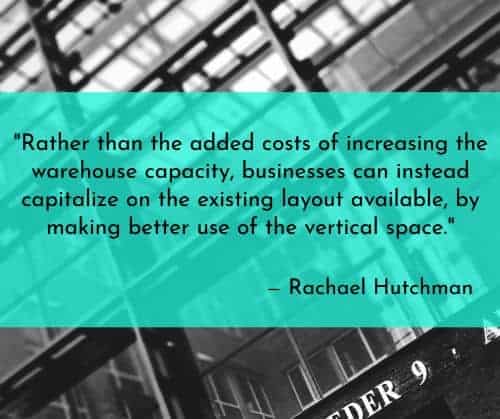
49. Optimize space utilization — without necessarily expanding your warehouse. “Expanding warehouse space isn’t the only option available for retailers looking to develop their warehouse operations. Rather than the added costs of increasing the warehouse capacity, businesses can instead capitalize on the existing layout available, by making better use of the vertical space. For example, companies can add taller storage units and choose suitable picking equipment that requires less space. Quite often, the wrong type of shelf is used for storing materials, wasting space that could otherwise be valuable for production, for example storing small items on pallet racks. It’s also a good idea to use standardized bins to help keep shelves neat and orderly.” — Rachael Hutchman, 6 ways to improve warehouse efficiency, Expert Manufacturer; Twitter: @ExpertManufact
50. Implement storage solutions based on picking needs. “Organize your warehouse by what works best for your business — either stocking materials by products that sell quicker than others, by groups of products most frequently sold together or by seasonal items. As your product mix will probably change over the years, plan your storage needs based on current and future order-picking needs, taking into account your projected growth.” — Boosting Warehouse Productivity, Inbound Logistics; Twitter: @ILMagazine
Interested in more? Let’s discuss the solution that’s right for you. Contact us today.


